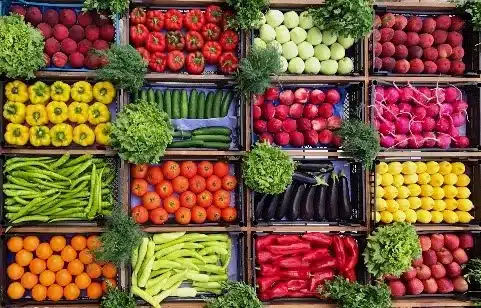Take good care of yourself when away from home whether on the road, at work or at school.
Why? Current evidence suggests that eating more vegetables, fruit, beans, legumes, seeds and nuts will reduce the risk of cardiovascular disease, diabetes, and certain types of cancer. Plus, you will feel better overall and save money! Put an emphasis on increasing cruciferous vegetables, dark leafy greens, citrus fruits, and berries. We humans are creatures of habit. Start slow and make more changes each week. Plan a weekly menu and cook batches on a free day. Many foods freeze well so cook once and eat many times. You will reap the benefits of money savings and good health. Contact Jill Larson for more information at jilll@hocgb.org. I am here to support you!
How to:
- Purchase an insulated beverage container. You will save money in the long run and be healthier by drinking mostly water. You can add a splash of lemon or fruit juice for flavor. A bonus is avoiding the burden of plastic container waste. Make your own tea or coffee so you can control sugar and cost.
- You will need an insulated tote or cooler and some ice packs to keep certain items cold. You may want a thermos type of food jar to keep some foods hot. Shop to find a good fit for your needs. It is an investment that you can use for years to come.
- Prepare a smoothie or overnight oats ahead of time. You can add ground flax, chia seeds, and yogurt to smoothies or oats. Eat for breakfast at home or pack it for later consumption.
- Cut up and pack carrots, celery, kohlrabi and bell peppers to eat with hummus.
- Make homemade granola for breakfast or snack.
- Grapes, berries, apples, oranges, and bananas are nature’s portable foods.
- Pack a couple of eggs to make microwave scrambled eggs in a mug. Add some of your cut vegetables to the eggs.
- Make and pack protein peanut butter balls with chocolate chips, ground flax, peanut butter (or other nut butter), honey and oats.
- Pack up homemade yogurt parfaits. Greek yogurt supplies more protein but watch out to keep added sugars to less than about 30 grams per day.
- Pack hard boiled eggs in cooler.
- Make a frittata using up refrigerator leftovers and pack for breakfast, lunch or even dinner. For every 12 eggs use ½ cup dairy (6 egg use ¼ cup dairy) and then add potatoes, vegetables and even beans to frittata bake. Experiment!
- Pack a whole grain bagel and cream cheese.
- Use cold cuts wrapped in cheese slice. Serve it with cut cucumbers, nuts, and grapes for a portable charcuterie board.
- Don’t forget the classic peanut butter (or other nut butter) and jelly on whole wheat bread! This is a complete protein source. Add sliced banana too.
- Make a green salad in a jar. Add cherry tomatoes and olive oil dressing.
- Make your own trail mix for snacks to keep hunger from resulting in last minute unhealthy (and expensive) food choices. Add dried apricots or raisins.
- Try a type of meat jerky. Look for a low sodium and sugar option.
- Pack canned tuna, chicken or salmon to be served on whole grain crackers or eaten with cut vegetables.
- Dark chocolate. There is nothing more to say about enjoying a small piece of chocolate now and then.
- Use yogurt and kefir for probiotics. Remember to keep added sugars to less than about 30 grams per day. Add other fermented foods. Sauerkraut and kimchi are great sandwich toppers.
Find local farmer markets and small locally owned restaurants to learn about local cuisine if eating out. Avoid deep fried foods, fast food chains, and salty, high sugar, low fiber processed products. It will go a long way to a healthy you!
Turkey and Potato Hand Pies.
Serve with a green salad packed in a side container. Keep in cooler or refrigerated. Some type of savory hand pie is found in many cuisines (e.g. samosa, pasties) so you can find many more recipes online. Experiment and enjoy these satisfying meals when at school, on the road or at work.
(Adapted from Delish.com)
Ingredients:
- 2 Tablespoons olive oil
- 1 medium onion (diced)
- salt and pepper
- 1 medium potato (diced) – Scrub it but you don’t need to peel it.
- 1 tsp. curry powder- Experiment with the seasonings. Try smoked paprika, cumin, etc.
- 3/4 c. frozen peas or corn
- 1/4 c. golden raisins
- 1 tbsp. red wine vinegar
- 1 1/2 c. shredded roasted turkey or chicken
- 2 refrigerated rolled pie crusts (can purchase premade or try making your own)
- 1 large egg (in bowl slightly beaten with a fork)
- Mixed green salad packed separately. Have a side of blackberries, blueberries or raspberries.
Directions:
Heat oven to 400 degrees Fahrenheit. Line a baking sheet with parchment paper (easy clean up). Heat the oil in a skillet pan over medium heat. Add the onion, ½ teaspoon salt and ¼ teaspoon pepper to cook stirring occasionally until transparent. Then add the potato (can microwave on plate with a bit of water for 1-2 minutes to speed cooking) to skillet, stirring occasionally until just tender (about 7 minutes). Stir in the seasonings and cook for 1 minute. Remove from heat and add peas, raisins, and vinegar. Mix well. Fold in the meat. Now you can unroll the pie crusts and cut each into 4 triangles. Divide the filling mixture among the pieces of dough. Fold the dough over the filling and press the edges with a fork to seal. Transfer to the prepared baking sheet. Brush the hand pies with the beaten egg and bake until golden brown (15-20 minutes). Serve with your separately packed salad or berries.




